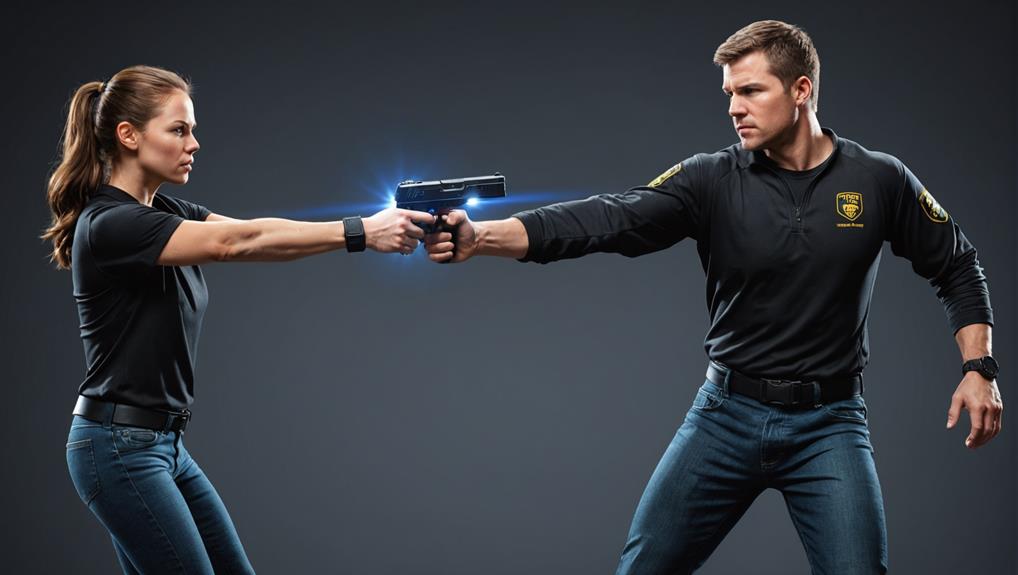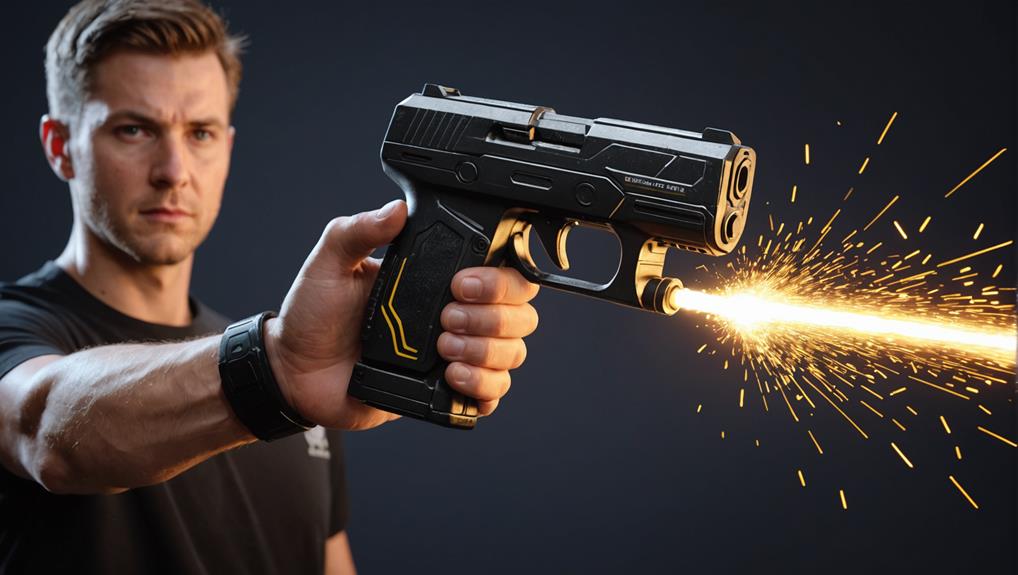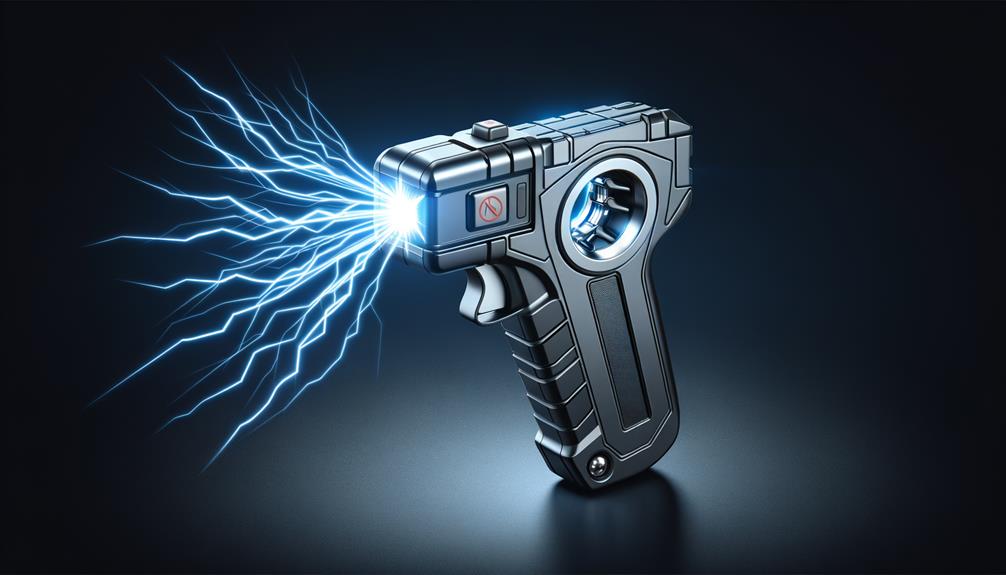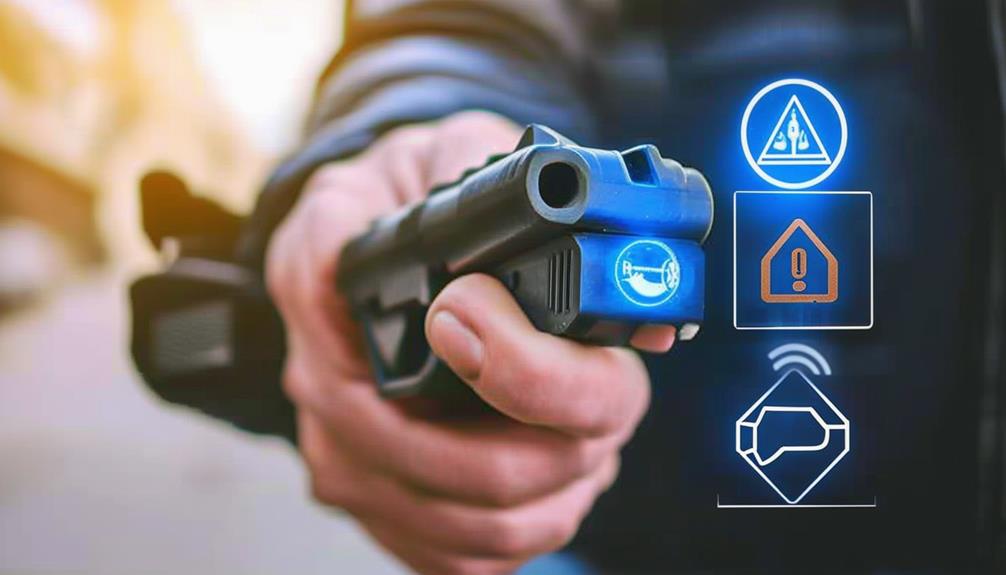
Brainstorm Security Shop

For Orders Over $199

On Any Of Our Products

Details On Refund Page
When faced with the choice between a stun gun and a Taser for self-defense, you might wonder which one is more effective in different scenarios. The decision could mean the difference between a close-range defense tool or the ability to incapacitate an attacker from a distance. Understanding the nuances of these devices’ functionalities and practical applications is crucial in making an informed decision. So, before you make your choice, consider exploring the key differences between stun guns and Tasers to ensure you’re equipped with the best option for your safety needs.

When comparing stun guns to Tasers, it’s essential to understand their basic functionality. Stun guns work by directly delivering an electric shock when pressed against the target. They operate on the principle of pain compliance, causing temporary immobilization and disorientation. The electrical current disrupts the normal functioning of the muscles, making it difficult for the person to move temporarily. Stun guns are effective at close range and require physical contact to deliver the shock.
On the other hand, Tasers function differently from stun guns. A Taser shoots two prongs attached to conductive wires towards the target. Upon hitting the target, the Taser delivers a high-voltage shock that overrides the central nervous system, causing involuntary muscle contractions and incapacitating the individual. Unlike stun guns, Tasers can be used from a distance, providing more flexibility and safety for the user in certain situations.
Understanding the basic functionality of stun guns and Tasers is crucial in determining which option aligns better with your personal safety needs and preferences. Please buy one stun gun or a taser for your protection so you can be safe. We care for the safety of our costumers.
The design and appearance of stun guns and Tasers play a significant role in their usability and effectiveness for personal safety. Stun guns are typically smaller and more compact, resembling a flashlight or a small handheld device. They often have a simple design with a button or switch to activate the electric shock. This compact size makes them easy to carry in a purse or pocket, providing quick access in case of an emergency.
On the other hand, Tasers have a more complex design, usually consisting of two parts connected by wires. One part is the handheld device that shoots out prongs to deliver an electric shock, while the other part houses the mechanisms and batteries. Tasers are often larger and bulkier than stun guns, which may affect their portability but also provide a more extended reach when needed.
Both stun guns and Tasers are designed to be visually intimidating, with bright colors and markings to deter potential attackers. The design and appearance of these devices can influence how effectively they’re used in dangerous situations, making them essential tools for personal safety.
Stun guns and Tasers vary in their range of effectiveness when used for personal safety.
Stun guns, which require direct contact with an attacker, have a limited range typically ranging from arm’s length to a few feet. This means that you must be in close proximity to the threat to use a stun gun effectively.
On the other hand, Tasers have a much greater range compared to stun guns. Tasers can reach a target from a distance of up to 15 to 30 feet, depending on the model. This extended range allows you to defend yourself from a safer distance, reducing the need to get physically close to an assailant.
When considering the range of effectiveness of a taser, it’s crucial to weigh your personal safety needs and the level of distance you may need to protect yourself.
Stun guns are suitable for close encounters, while Tasers provide a more versatile defense option with their longer reach. Choose the self-defense tool that best aligns with your comfort level and the potential threat scenarios you may encounter.
Considering legal implications, it’s essential to be aware of the regulations surrounding the possession and use of Tasers in your jurisdiction. In many places, Tasers are classified as restricted weapons, requiring permits for ownership and usage. It’s crucial to familiarize yourself with local laws to avoid legal repercussions.
When it comes to Tasers vs Stun Guns, some regions allow the carrying of Taser for personal protection, but others may have strict guidelines or outright bans on civilian Taser use. It’s your responsibility to understand the legal framework governing Tasers to ensure compliance.
Moreover, the use of Tasers in certain situations, such as law enforcement or security roles, may have specific training requirements and protocols mandated by law. Failure to adhere to these regulations can result in serious consequences.
Before purchasing or using a Taser, consult with legal authorities or seek guidance from professionals to navigate the legal landscape effectively. Stay informed about any updates or changes in the laws regarding Tasers to safeguard yourself legally.
Understanding the safety features of Tasers is crucial for responsible ownership and usage. Tasers are designed with several safety mechanisms to prevent accidental discharge and ensure effective use. One key safety feature is the safety switch, which requires deliberate activation before the Taser can be fired. This helps prevent unintended use, especially in situations where quick decisions must be made.
Another important safety aspect is the targeting mechanism of Tasers. Most models utilize laser sights to assist in aiming accurately, reducing the risk of stray shots. Additionally, Tasers have built-in safeguards to limit the number of times they can be fired in succession, preventing potential misuse or prolonged exposure to electrical shocks.
Moreover, Tasers are equipped with safety features that automatically shut off the electrical current after a certain duration, minimizing the risk of overuse. These features not only protect the user but also the target from excessive harm.

To ensure safe and effective use of Tasers, proper training is essential. Tasers require specialized training due to their ability to immobilize targets from a distance. Training programs typically cover topics such as understanding the weapon’s functions, proper aiming techniques, deployment considerations, and post-use procedures. It’s crucial to be familiar with the laws and regulations surrounding Taser usage in your jurisdiction.
Hands-on practice under the supervision of qualified instructors is a key component of Taser training. This practical experience helps users gain confidence in handling the weapon accurately and responsibly. Additionally, training emphasizes de-escalation techniques and situational awareness to minimize the need for Taser deployment.
While stun guns may require less training compared to Tasers, it’s still important to receive proper instruction on how to use them safely. Understanding the differences between stun guns and Tasers, as well as their respective training requirements, is essential for individuals considering the use of these devices.
Training requirements play a significant role in the overall costs associated with using Tasers and stun guns, making it important to compare the financial aspects of these two self-defense tools.
When considering costs, stun guns are generally more affordable upfront than Tasers. A basic stun gun can range from $10 to $100, depending on the brand and features. On the other hand, Tasers are more expensive, with prices ranging from $400 to $1,500 for a single unit.
However, the long-term costs should also be taken into account. Stun guns are usually battery-operated, requiring occasional battery replacements that can add up over time. In contrast, Tasers often come with rechargeable batteries, reducing ongoing expenses.
Additionally, some stun guns may need occasional maintenance or replacement due to wear and tear, adding to their overall cost.
When comparing the costs of these self-defense tools, it’s essential to consider not only the initial purchase price but also any additional expenses that may arise during their lifetime.
Portability and size significantly impact the usability and effectiveness of stun guns and Tasers in self-defense situations. When considering a self-defense tool, the convenience of carrying it with you at all times is crucial. Stun guns are generally smaller and more compact compared to Tasers, making them easier to carry in a purse, pocket, or clipped onto a belt. Their smaller size allows for discreet carrying, ensuring that you have quick access to the device in case of an emergency.
On the other hand, Tasers tend to be larger and bulkier due to their additional components like cartridges and probes. While they may offer longer-range capabilities, their size can make them less practical for everyday carry. The bulkiness of a Taser may limit where and how you can carry it, potentially affecting your ability to deploy it swiftly when needed.
Therefore, when considering portability and size, stun guns often have the upper hand in terms of convenience and ease of carrying for self-defense purposes.

When facing attackers, the effectiveness of stun guns and Tasers in incapacitating threats quickly becomes a critical factor in determining the outcome of a self-defense situation.
Stun guns deliver an electric shock upon contact with the attacker’s body, causing pain and muscle contractions, which can momentarily disable the assailant. However, stun guns require direct contact with the attacker, which may not always be feasible in a dangerous situation.
On the other hand, Tasers can incapacitate attackers from a distance by shooting probes that deliver an electric shock, disrupting the body’s neuromuscular system and causing temporary immobilization. This allows for a safer distance between you and the attacker while still effectively neutralizing the threat.
Tasers are preferred by some individuals for their ability to subdue attackers without the need for close contact.
Regular maintenance is essential to ensure the optimal performance and longevity of both stun guns and Tasers. To keep your devices in top condition, start by regularly inspecting them for any visible damage, such as cracks or loose components. Clean the exterior of your stun gun or Taser with a damp cloth and mild detergent to remove any dirt or residue that could affect its functionality.
It’s crucial to regularly test your device to ensure it’s functioning correctly. For stun guns, activate the device for a brief moment to confirm that the electrical charge is being emitted. Similarly, for Tasers, ensure that the cartridges aren’t expired and conduct test firings to guarantee the electrical probes deploy effectively.
Store your stun gun or Taser in a cool, dry place away from direct sunlight and extreme temperatures. Avoid dropping or mishandling the devices to prevent unnecessary damage.
Following these maintenance practices will help ensure that your stun gun or Taser is ready for use whenever needed.
In conclusion, when choosing between a stun gun and a Taser for self-defense, consider factors such as range, design, portability, and effectiveness against attackers.
Both devices have their own advantages and limitations, so it’s important to select the option that best suits your needs and preferences.
Stay informed about legal considerations and safety features, and always prioritize proper maintenance and care to ensure your personal protection device functions effectively when needed.

Brainstorm Security Shop
1867 Caravan Trail
Ste 105
Jacksonville, FL 32216
Call us toll free: (800) 859-5566